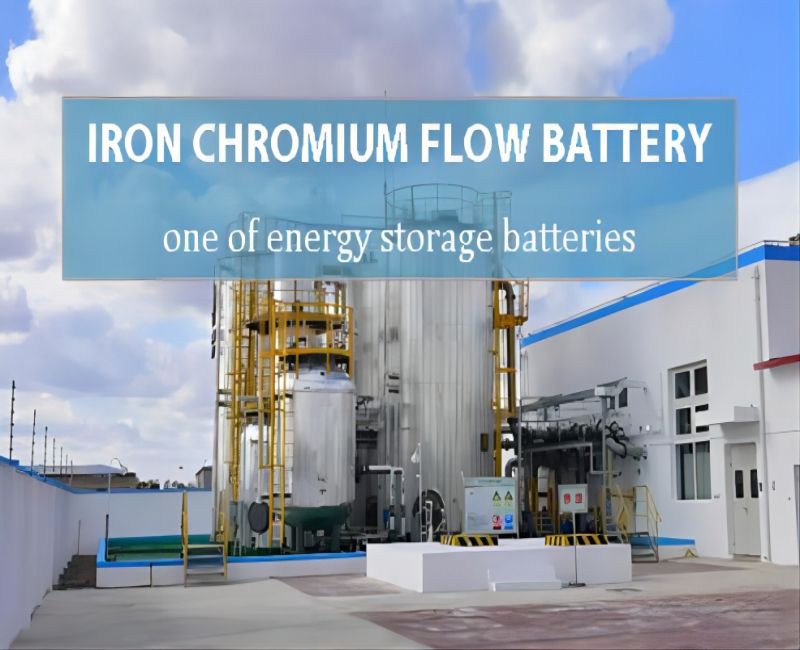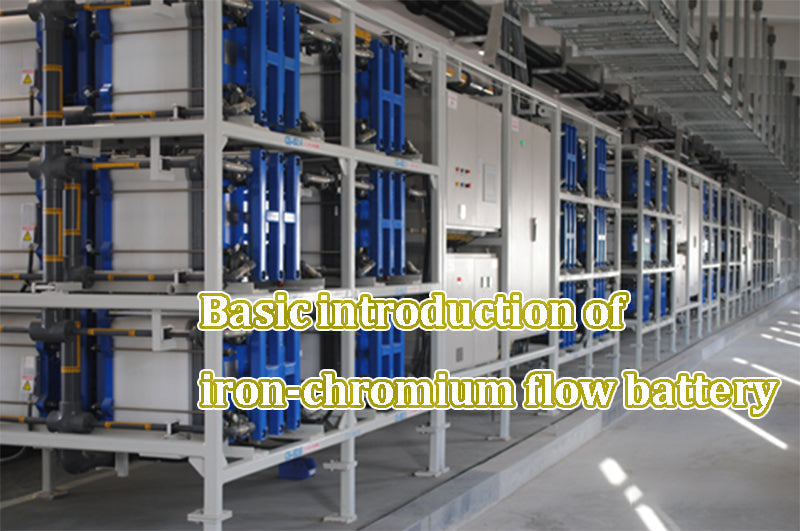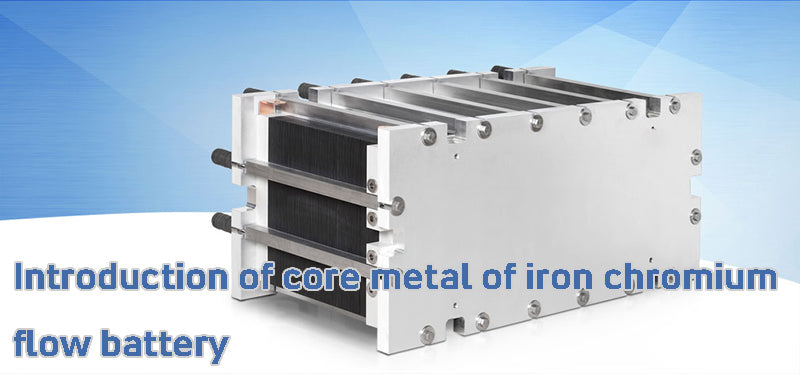
Main content:
With the transformation and adjustment of China's energy structure, energy storage is facing unprecedented opportunities and explosive demand growth. Among the many energy storage technologies, iron chromium flow battery is a large-scale energy storage technology with great development potential.
Basic introduction of iron chromium flow battery
A flow battery is an electrochemical battery in which both the positive and negative active materials are liquid. It is composed of point stack unit, electrolyte, electrolyte storage and supply unit and management control unit. It is a competitor in an emerging field of batteries.
Flow batteries are different from ordinary batteries that usually use solid electrodes as electrodes. The active materials of flow batteries are stored in liquid form in two separate storage tanks, and the electrolyte solution is driven by a pump to react in an independent battery stack.
It is separated from the liquid storage tank and operates at normal temperature and pressure. Iron chromium flow battery are the most concerned flow batteries and can be divided into four categories. First, the all-vanadium flow battery is currently the most mature and industrialized flow battery technology. The most important factor limiting its development is the high cost of electrolyte caused by the drastic change in vanadium prices.
Second, the emerging iron chromium flow battery, also known as iron chromium redox flow battery, is currently relatively mature in technology, and the cost is lower than that of full alum flow battery. Third, lead-acid flow batteries. The initial design cost of lead-acid flow batteries is relatively low, but the number of cycles is relatively low, and the later maintenance costs are relatively high. Fourth, lithium-ion flow batteries.

From the comparison of current density and energy cycle efficiency, the future large and medium-sized energy storage may focus on all-vanadium and iron chromium, and the small and short-term energy storage will focus on the use of lithium batteries and sodium batteries. As for the differences between lithium vs sodium battery, you can click our article to know more about it.
The principle of iron chromium flow battery
The electrolyte solution of the iron chromium flow battery energy storage unit is an aqueous solution of hydrochloride. When the iron chromium redox flow battery is discharged, Cl- will move to the negative electrode, and the negative electrode reaction is: Cr2+=Cr3++e-, the reverse reaction is the same as the cathode reaction during charging.
During charging, the ions lose electrons on the anode and undergo an oxidation reaction, that is, Ce2+ gains electrons to form Fe3+, and the electrode reaction is: Fe2+-e-═Fe3+, the reverse reaction is the same as the reaction on the positive electrode during discharge.
Application of iron chromium flow battery
Because the electrolyte solution of iron chromium flow battery is an aqueous solution, its density and volume weight are not suitable for electric vehicles. Mainly used in the field of photovoltaic energy storage, widely used in the power generation side, the grid side and the user side, from providing short-term frequency regulation, improving power quality to long-term peak shaving and valley filling, alleviating transmission line congestion, and can provide time-space transfer of energy.
It is an important measure to solve the problems caused by the integration of large-scale new energy power generation into the grid and to improve the grid's ability to accommodate it. According to estimates, every 1 GW of iron chromium flow battery energy storage system put into operation with a storage duration of 6 hours can increase the on-grid power of high-quality wind power and generation of photovoltaic power station by 1,980 GWh, directly reduce carbon emissions by about 1.96 million tons, and reduce dust emissions by about 540,000 tons, equivalent to about 750,000 tons of replacing standard coal.

Advantages of iron chromium flow battery
The number of cycles is large and the service life is long. The cycle life of iron chromium flow battery can reach a minimum of 10,000 times, which is equal to that of all-vanadium flow batteries, and the lifespan is much higher than that of sodium-sulfur batteries, lithium-ion batteries and lead-acid batteries.
There is no possibility of explosion, and the safety is high. The electrolyte solution of the iron chromium flow battery is an aqueous solution, and there is no risk of explosion. And the electrolyte solution is stored in two separate liquid storage tanks, the battery stack is separated from the liquid storage tank, and it operates under normal temperature and pressure with high safety.
The toxicity and corrosiveness of the electrolyte solution are relatively low, and the stability is good. The electrolyte solution of iron chromium flow battery is a dilute hydrochloric acid solution containing iron salts and chromium salts, which is relatively low in toxicity and corrosiveness.
Strong environmental adaptability and wide operating temperature range. Compared with other flow batteries, the iron chromium flow battery has a wider operating temperature, and the electrolyte solution can be started in the full range of -20 to 70 °C.
Storage tank design, no self-discharge. Electric energy is stored in the electrolyte solution, and the electrolyte solution is stored in the storage tank, so there is no self-discharge phenomenon, especially suitable for backup power supply, etc.

Customized design, easy to expand. The rated power and rated capacity of the iron chromium flow battery are independent. The power depends on the battery stack, and the capacity depends on the electrolyte solution. The power and capacity can be tailored according to user needs. Under the condition that the power requirement remains unchanged, it is very simple to expand the capacity only by adding the electrolyte solution.
Modular design, high system stability and reliability. The iron chromium flow battery system adopts a modular design. Taking a 250 KW module as an example, a module consists of 8 battery stacks placed in a standard container, so the consistency between the battery stacks is good, the system control is simple, and the performance is stable reliable.
Waste batteries are easy to handle, and the electrolyte solution can be recycled. The structural material, ion exchange membrane and electrode material of the iron chromium flow battery are metal, plastic (or resin) and carbon material respectively, which are easy to carry out environmental protection treatment, and the electrolyte solution can theoretically be recycled permanently.
Abundant resources and low cost. The raw materials of the electrolyte solution are rich in iron and chromium resources, and the cost is low compared to other flow batteries, and there will be no short-term resource constraints on development, so it is a sustainable energy storage technology.
Introduction of core metal of iron chromium flow battery
Chromium industry chain
Chromite is divided into metallurgical grade, chemical grade, refractory grade and cast stone grade according to industrial uses, of which metallurgical grade chromite accounts for more than 95% of the worldwide production. Due to the properties of wear resistance, high temperature resistance, battery corrosion resistance and ferrophilicity, metallurgical grade chromite is smelted into ferrochromium alloys and added to stainless steel, special steel and other steels.

Stainless steel is currently the largest consumer of chromium, and it has the main characteristics of stainless and corrosion resistance because of its nickel-chromium content.
According to different carbon content, ferrochromium is divided into high carbon ferrochromium (carbon content of 4~8%), medium carbon ferrochromium (carbon content of 0.5~4%), low carbon ferrochromium (carbon content of 0.15~0.50%), Micro-carbon ferrochromium (carbon content is 0.06%), ultra-micro carbon ferrochromium (carbon content is less than 0.03%). Medium, low and micro-carbon ferrochromium is smelted from high-carbon ferrochromium by adding silica, and it is also widely used in processing special steel due to its low carbon content.
In addition, chemical grade chrome ore can also be processed into chrome oxide green, chrome trioxide, sodium red alum and other chrome salts, which are used in pigments, coatings, ceramics, feed, electroplating, alloys, leather and many other industries. Ferrochromium electrolysis and chromium salt carbon reduction can be purified to metallic chromium. With the commercialization of iron chromium flow battery, the battery field may become a new consumption growth point in the future.
Resource distribution
The world is rich in chromite resources, mainly distributed in South Africa, Zimbabwe, Kazakhstan, Turkey and other countries. Among them, South Africa has the largest amount of resources, accounting for about half of the world's total resources, and is the world's largest exporter of chromium resources.
In 2020, the world's chrome ore resources are about 9 billion tons, the basic reserves are 1.382 billion tons, and the reserves are 685 million tons. In 2021, the world's chrome ore production will be 34.8 million tons, a month-on-month increase of 7%. South Africa, Kazakhstan, India, Turkey, Finland and other five countries account for 94% of the world's total chrome ore output.
Chromium salt market
Sodium dichromate is the most basic product of chromium salts. Through deep processing, various inorganic and organic products containing chromium such as chromic anhydride and chrome green can be produced. China is the world's largest producer and consumer of chromium salts, and the world's chromium salt industry is highly concentrated, gradually forming a market pattern in which there is only one leading chromium salt enterprise in a certain region.
American Hemmings dominates the North American market. Turkey's Jinshan Group is based in the Middle East and has branches all over the world. India's Vishay radiates South Asia. Germany's Lanxess headquarters produces chrome salt pigments that still occupy a monopoly in the world market. Zhenhua Co., Ltd. is the only listed company in China's chrome salt industry. Its production scale, technical level, product quality and market share are in the leading position in China, and its production capacity accounts for more than half of the country.
Related article: top 10 vanadium battery companies, vanadium battery vs lithium, lithium cobalt oxide battery